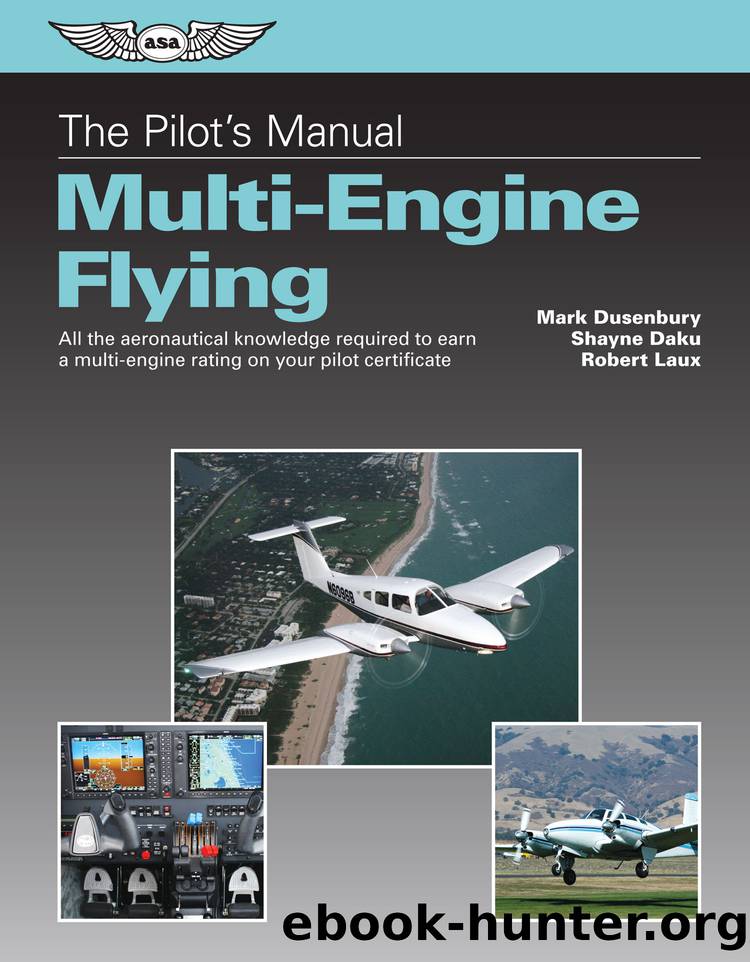The Pilot's Manual: Multi-Engine Flying by Dusenbury Mark;Daku Shayne;Laux Robert;

Author:Dusenbury, Mark;Daku, Shayne;Laux, Robert;
Language: eng
Format: epub
Publisher: Aviation Supplies & Academics, Inc.
Published: 2015-04-17T00:00:00+00:00
Conventionally Rotating Twin
In a conventional twin aircraft, both propellers will turn to the right (clockwise) from the pilotâs perspective (Figure 10-7). This engine mounting defines a number of specific characteristics of a conventional twin, including left-turning tendencies, a critical engine, and single-engine controllability (all of which are covered in detail in Chapter 11).
Figure 10-7. Propeller rotation in a conventional twin.
Installing the same engine on both sides of the aircraft can have significant financial benefits. As an individual or a commercial operator, maintenance and parts can be a large expense for an aircraft. Maintenance with the conventional twin will be the same for both engines. This will reduce the complexity of the procedures and minimize aircraft downtime. In addition, since both engines use the same the parts, parts inventory for those engines will be reduced compared to the counter-rotating type of twin.
Download
This site does not store any files on its server. We only index and link to content provided by other sites. Please contact the content providers to delete copyright contents if any and email us, we'll remove relevant links or contents immediately.
| Airport | Commercial |
| Helicopters | History |
| Pictorial | Piloting & Flight Instruction |
| Repair & Maintenance |
Small Unmanned Fixed-wing Aircraft Design by Andrew J. Keane Andras Sobester James P. Scanlan & András Sóbester & James P. Scanlan(32157)
Navigation and Map Reading by K Andrew(4570)
Endurance: Shackleton's Incredible Voyage by Alfred Lansing(3878)
Wild Ride by Adam Lashinsky(1664)
And the Band Played On by Randy Shilts(1635)
The Box by Marc Levinson(1607)
Top 10 Prague (EYEWITNESS TOP 10 TRAVEL GUIDES) by DK(1575)
The Race for Hitler's X-Planes: Britain's 1945 Mission to Capture Secret Luftwaffe Technology by John Christopher(1534)
The One Percenter Encyclopedia by Bill Hayes(1476)
Girls Auto Clinic Glove Box Guide by Patrice Banks(1375)
Trans-Siberian Railway by Lonely Planet(1354)
Looking for a Ship by John McPhee(1328)
Batavia's Graveyard by Mike Dash(1309)
Fighting Hitler's Jets: The Extraordinary Story of the American Airmen Who Beat the Luftwaffe and Defeated Nazi Germany by Robert F. Dorr(1308)
Troubleshooting and Repair of Diesel Engines by Paul Dempsey(1291)
Bligh by Rob Mundle(1281)
TWA 800 by Jack Cashill(1260)
The Great Halifax Explosion by John U. Bacon(1238)
Ticket to Ride by Tom Chesshyre(1236)
